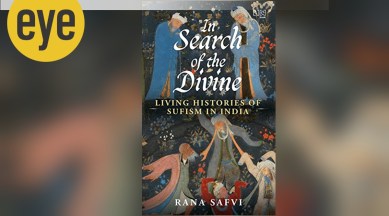In ‘In Search of the Divine: Living Histories of Sufism in India’, Rana Safvi maps a millennium of shared spirituality
The writer weaves together a narrative that combines history and geography, myth and contemporary practices of Sufism, writes Raza Mir

Ye masaail-e tasawwuf,
ye tera bayaan, Ghalib
Tujhe hum wali samajhte,
jo na baada-khwaar hota
(These scholarly Sufi discussions, and your speech, Ghalib, you thinker
We would have thought you a saint, had you not been a wine drinker!)
The above lines by Ghalib, characteristically mischievous, also point to the fact that the bard of 19th-century India thought of himself as being close to the Sufi tradition. Indeed, Indian Sufism, which traces its origin to the 12th century CE, was quite mature in the nation’s ethos by Ghalib’s time. A great number of dargahs already dotted the landscape of the subcontinent. These included the shrine of Baba Fariduddin Ganjshakar (1188-1266) in Pakpattan, Khwaja Moinuddin Chishti’s (1143-1236) resting place in Ajmer, the mausoleum of Hazrat Nizamuddin Auliya (1238-1325) in Delhi, and even as far south as Nagore in present day Tamil Nadu, where Hazrat Syed Shahul Hameed (d. 1570) was welcomed by the king of Thanjavur with a land grant to build a khanqah, or seminary. The last named saint is revered as “Nagore Andavar” by locals and is one among thousands of examples where Hindus and Muslims continue to share sacred spaces in India.
The word ‘Sufi’ has a rather prosaic meaning. It literally refers to “the act of wearing wool,” perhaps referring to the shawls worn by the itinerant preachers who travelled the length and breadth of the Middle East, Central Asia and South Asia. These holy men (and a few women such as Rabia Basri) were not afraid to venture into lands where they knew neither language nor custom, begged for their sustenance, and often spoke in incomprehensible metaphors. Yet, not only did many of them attract large multitudes of followers, they alarmed local rulers enough that several were put to death. The execution of Nurullah Shustari by emperor Jahangir in Agra, or the beheading of Sarmad Kashani by Aurangzeb are but two examples of the fate that befell some of these personages in India, often on the charge of apostasy. However, such acts of terror often had the opposite effect; the popularity of these saints often soared after their deaths, resulting in shrines, festivals, and stories about their miracles.
In In Search of the Divine: Living Histories of Sufism in India, Rana Safvi has attempted the daunting task of mapping out the Sufi traditions in the subcontinent. Intertwining personal testimony with a taxonomy of the different silisilahs of Sufism, Safvi weaves together a narrative that combines history and geography, myth and contemporary practice. Her writing is often imbued with a winsome visuality. Consider for example, the description of the Sarkhej Roza, a shrine in Gujarat: “These square panels were patterned in three ways: geometric, curvilinear, or a combination of both. Floral motifs were also used to heighten the sense of being in a garden — as that is how paradise is also described. In the tomb of Sheikh Ghaus Gwaliori, there are over a hundred panels with one screen comprised of both geometrical and stylized designs.” Such descriptions bring the shrines to life in a unique manner. Safvi has clearly travelled the length and breadth of India to describe a variety of shrines, some immensely popular, others forlorn and forgotten.
The book offers valuable source material to those who are interested in the history of Sufism in India, its various orders (Chishti, Qadiriyya, Suhrawardiyya, Naqshbandi, and other minor traditions), its linkages to the family of Prophet Mohammad, and its interlinkages with Hindu traditions. Consider, for example, a conversation she reports with a caretaker of a shrine in Kakori in Uttar Pradesh: “Once he (Shah Kazim Qalandar) was in a state of deep anxiety when he saw Krishnaji in his dream. He said, ‘I want death.’ Krishnaji soothed him and said: Tum amar ho (You are immortal), suggesting that someone whose heart is lit up with love is freed of the bondage of time and space, life and death.”
These heartwarming depictions of an intertwined spirituality offer a space of optimism at a time when inter-religious relations in India assume more and more of a fraught dimension.
If I had one complaint with the book, it had to do with the relentlessly rosy picture it depicted, not just of Sufi myth but current practice. There is no mention of shrine caretakers duping gullible pilgrims, of them preying on the desperate by offering impossible cures, of rampant misogyny on the part of some administrators and so forth.
However, these are minor quibbles. The book itself is a bravura performance that maps the world of Sufism for both the neophyte and the serious researcher. By writing it, Safvi has done us all a singular service.
Raza Mir teaches management at William Paterson University, USA. He is the author of several books of translation and literary criticism on Urdu poetry as well as the novel, Murder at the Mushaira